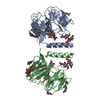+Search query
-Structure paper
| Title | Olfactomedin-1 Has a V-shaped Disulfide-linked Tetrameric Structure. |
|---|---|
| Journal, issue, pages | J Biol Chem, Vol. 290, Issue 24, Page 15092-15101, Year 2015 |
| Publish date | Jun 12, 2015 |
 Authors Authors | Matti F Pronker / Trusanne G A A Bos / Thomas H Sharp / Dominique M E Thies-Weesie / Bert J C Janssen /  |
| PubMed Abstract | Olfactomedin-1 (Olfm1; also known as noelin and pancortin) is a member of the olfactomedin domain-containing superfamily and a highly expressed neuronal glycoprotein important for nervous system ...Olfactomedin-1 (Olfm1; also known as noelin and pancortin) is a member of the olfactomedin domain-containing superfamily and a highly expressed neuronal glycoprotein important for nervous system development. It binds a number of secreted proteins and cell surface-bound receptors to induce cell signaling processes. Using a combined approach of x-ray crystallography, solution scattering, analytical ultracentrifugation, and electron microscopy we determined that full-length Olfm1 forms disulfide-linked tetramers with a distinctive V-shaped architecture. The base of the "V" is formed by two disulfide-linked dimeric N-terminal domains. Each of the two V legs consists of a parallel dimeric disulfide-linked coiled coil with a C-terminal β-propeller dimer at the tips. This agrees with our crystal structure of a C-terminal coiled-coil segment and β-propeller combination (Olfm1(coil-Olf)) that reveals a disulfide-linked dimeric arrangement with the β-propeller top faces in an outward exposed orientation. Similar to its family member myocilin, Olfm1 is stabilized by calcium. The dimer-of-dimers architecture suggests a role for Olfm1 in clustering receptors to regulate signaling and sheds light on the conformation of several other olfactomedin domain family members. |
 External links External links |  J Biol Chem / J Biol Chem /  PubMed:25903135 / PubMed:25903135 /  PubMed Central PubMed Central |
| Methods | EM (tomography) / X-ray diffraction |
| Resolution | 2.4 Å |
| Structure data |  EMDB-2940:  EMDB-2941:  EMDB-2942:  EMDB-2943:  EMDB-2944:  PDB-5amo: |
| Chemicals |  ChemComp-NAG:  ChemComp-GOL:  ChemComp-CL:  ChemComp-HOH: |
| Source |
|
 Keywords Keywords |  SIGNALING PROTEIN / OLFM1 / SIGNALING PROTEIN / OLFM1 /  DISULFIDE / DISULFIDE /  NEUROBIOLOGY / DEVELOPMENT / NEUROBIOLOGY / DEVELOPMENT /  AMPA RECEPTOR / AMPA RECEPTOR /  BETA PROPELLER BETA PROPELLER |
 Movie
Movie Controller
Controller Structure viewers
Structure viewers About Yorodumi Papers
About Yorodumi Papers




